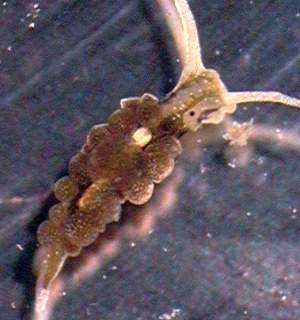
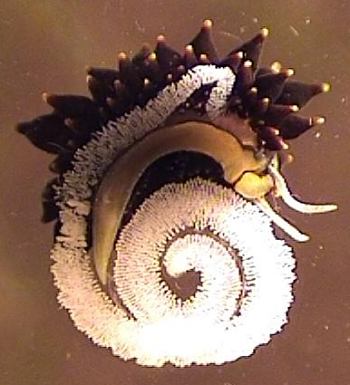
Ercolania viridis
(A. Costa, 1866)
Order: SACOGLOSSA
Superfamily: LIMAPONTIOIDEA
Family: Limapontiidae
DISTRIBUTION
Mediterrean, Alantic coast of Europe and Nth America, Caribbean.
PHOTO
Upper Photo: Lac de Tunis [southern section], Tunisia. Depth: 0 to 1m, January - March, 2003. 3-4mm long. Photo: Anis
Lower photo: Ukraine, Black Sea coast. Photo: Alexander Kurakin
Ercolania viridis is very variable in colour and consequently has a very confused nomenclatural history which has been compounded by the fact that species in two very similar looking genera, Stiliger and Placida, also have species named 'viridis' living in the same geographic region. [See discussion below.]
It ranges in colour from almost transparent, with the green of the digestive gland ducts, and the brownish colour of the viscera showing through, to animals which are heavily pigmented with black. Intermediate animals often have red speckling or dusting on the ceratal wall. The black form was named E. funerea by Costa (1867). Ercolania funerea has usually been a considered a synonym of Ercolania viridis but the name has often been used in preference to Ercolania viridis because of the possible confusion with Placida viridis and Stiliger viridis.
Vayssiere (1888) describes specimens from Marseilles in some detail. In colour he describes the body as being translucent with a blackish green or violet green tinge. There is an opaque white mark on the head and another from the pericardial hump back down the median line between the cerata. The cerata have a blackish green tinge but the green branching of the digestive gland is clearly visible. There is often a reddish tip to the cerata. In some animals a blackish tinge to the skin dominates the colour of the animal. Marcus & Marcus (1970) describe animals from Puerto Rico, in the Caribbean, as being 'blackish with clear rhinophores, tail, and pericardial area; cerata black with reddish brown tips; a patch of reddish brown on the head'.
Note: See Ercolania cf viridis for similar animal with quite different egg mass.
-
Costa, A. (1866) Saggio sui molluschi eolididei del Golfo di Napoli. Annuario del Museo Zoologico della Universita di Napoli, 3(2): 59-80.
-
Costa, A. (1867) Saggio sui molluschi eolididei del Golfo di Napoli. Annuario del Museo Zoologico della Universita di Napoli, 4(2): 26-37, pls. 1-2.
-
García Gómez, J.C. (2002) Paradigmas de una Fauna Insolita: Los Moluscos Opistobranquios del Estrecho de Gibraltar Instituto de Estudios Campogibraltarenos. Serie Ciencias 20. 397 pp.
-
Marcus, Er. & Marcus, Ev. (1970) Opisthobranchs from Curacao and faunistically related regions. Uitqaven van der Natuurwetenschappelijke Studiekring voor Suriname en de Nederlandse Antillen, 59: 1-129.
-
Marin, A. & Ros, J.D. (1988) The Sacoglossa (Mollusca, Opisthobranchia) of the South East Iberian peninsula. A Catalogue of species and presence of algal chloroplasts in them. Iberus, 8(1): 25-49. [In Spanish]
-
Ortea, J.A. & Urgorri, V. (1981) Opisthobranquios nuevos para el litoral iberico colectados en Galicia. I. Boletin del Instituto Espanol de Oceanografia, 6(288): 49-60.
-
Pruvot-Fol, A. (1954): Mollusques Opisthobranches Faune de France, 58: 1-460, Pl.1.
-
Vayssiere, A. J. B. M. 1888. Recherches zoologiques et anatomiques sur les mollusques Opisthobranches du Golfe de Marseille. Deuximem Partie, Nudibranches (Cirrobranches) et Ascoglosses. Annales du Musee d'Histoire Naturelle de Marseille, 3. Mem. 4: 1-160, pls. l-17.
Rudman, W.B., 2003 (June 5) Ercolania viridis (A. Costa, 1866). [In] Sea Slug Forum. Australian Museum, Sydney. Available from http://www.seaslugforum.net/find/ercoviri
Related messages
Ercolania? from Tunisia
July 28, 2003
From: J. Ben Souissi and A. Eters

Dear Bill,
Thanks for your identifications. Here is another one from our coastal lagoon.
"Lac de Tunis" [south section] in Tunis, Tunisia, North Africa. Depth: 0 to 1m some time between January and March, 2003.
Can you identify it please.
Thanks,
Jamila Ben Souissi and Anis Eters
mal_de_toi@cybercartes.com
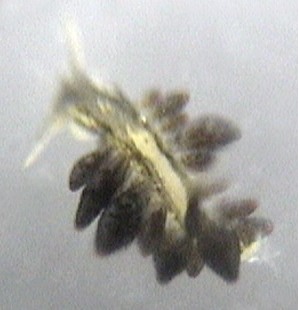

Dear Jamila & Anis,
I suspect this is the same species as the one in your earlier message, Ercolania viridis, but I think we should wait for comments from colleagues with a knowledge of the local fauna
Best wishes,
Bill Rudman
Re: Ercolania viridis? from Tunisia
June 7, 2003
From: Kathe R. Jensen
Dear Bill & Anis,
These animals look exactly like the ones I identified as Ercolania funerea during the workshop in Sicily in 1999. Ercolania funerea is a synonym of E. viridis. I think Vaysierre selected E. funerea as the valid name, but I cannot remember his reasoning. E. viridis is the oldest name, but since there is also a Stiliger viridis and a Placida viridis, and Ercolania viridis was originally described as Embletonia, which might conceivably be either one of the above 3 genera, I have been using E. funerea to avoid confusion. I wrote a short "popular" paper about the problem of naming a green slug "viridis" many years ago:
• Jensen, K.R. 1984. A nomenclatural problem in the Ascoglossa - or: Why one should never name a green sea-slug "viridis". Shells and Sea Life, 16: 188-190.
Best wishes,
Kathe Jensen
krjensen@zmuc.ku.dk
Thanks Kathe,
I had noted that 'viridis' had been used a lot and as you say it makes it very confusing. However since Embletonia funerea Costa 1867 was published a year later than Embletonia viridis Costa, 1867, I can't see Vayssiere had any valid nomenclatural grounds for using Ercolania funerea rather than Ercolania viridis. I note that Pruvot-Fol (1954) and Ortea & Urgorri (1981) also consider E. funerea to be a synonym.
I guess it is confusing to use Ercolania viridis but it is also confusing NOT to use it, since it appears to be the valid name.
• Costa, A. (1866) Saggio sui molluschi eolididei del Golfo di Napoli. Annuario del Museo Zoologico della Universita di Napoli, 3(2): 59-80.
• Costa, A. (1867) Saggio sui molluschi eolididei del Golfo di Napoli. Annuario del Museo Zoologico della Universita di Napoli, 4(2): 26-37, pls. 1-2.
• Ortea, J.A. & Urgorri, V. (1981) Opisthobranquios nuevos para el litoral iberico colectados en Galicia. I. Boletin del Instituto Espanol de Oceanografia, 6(288): 49-60.
• Pruvot-Fol, A. (1954): Mollusques Opisthobranches Faune de France, 58: 1-460, Pl.1.
Best wishes,
Bill Rudman
Re: Ercolania viridis from Tunisia
June 7, 2003
From: J. Ben Souissi & A. Eters
Dear Bill,
Concerning your question about the species that you identified as being Ercolania viridis. It was isolated in an aquarium containing only filtered sea water and a clean fragment of Ulva rigida. The eggs were noticed 4 days later so I am certain that they belong to this animal. The size of the egg ribbon is microscopic. The photograph that you have is taken under a magnifying glass with camera connected to the computer.
Cordially,
Jamila Ben Souissi & Anis Eters
bensouissi.jamila@inat.agrinet.tn
Ben Souissi, J. & Eters, A., 2003 (Jun 7) Re: Ercolania viridis from Tunisia. [Message in] Sea Slug Forum. Australian Museum, Sydney. Available from http://www.seaslugforum.net/find/10174Dear Jamila & Anis,
Thanks for the information on the egg ribbon. As you will see, Kathe Jensen's message confirms that the blackish animal's I have previously had on the Forum as Ercolania funerea are the same species as your animal. As you will see there is a nice photo of the egg ribbon from the Black Sea which is very similar to yours.
Best wishes
Bill Rudman
Ercolania viridis? from Tunisia
June 4, 2003
From: Anis Eters
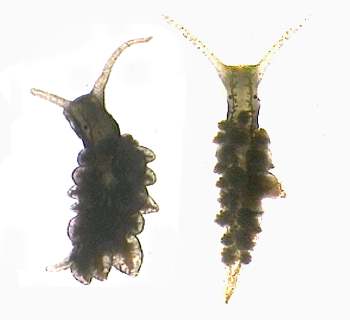
Dear Bill,
I found this sea slug in a coastal lagoon, Lac de Tunis [southern section] in Tunis, Tunisia, North Africa. Depth: 0 to 1m some time between January and March, 2003. size: 3-4mm. Substratum : muddy bottom amongst Ulva rigida
Can you identify it please.
Thanks,
Anis.
bensouissi.jamila@inat.agrinet.tn
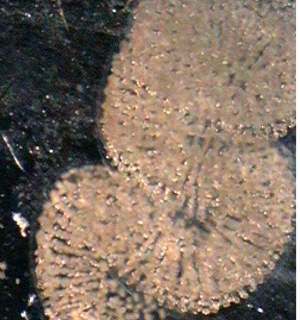

Dear Anis,
This is a sacoglossan, but I am not sure how easy it will be to identify without some anatomical information. Did you see the egg ribbon being layed or was it found with the animals? Why I ask is that it is often risky to assume that an egg mass belongs to the closest available animal. Hopefully one of our European colleagues will be able to identify it.
It looks very like an animal identified by Garcia-Gomez (2003) as Ercolania viridis (A. Costa, 1866). Garcia-Gomez considers Ercolania funerea (A. Costa, 1867), which is discussed elsewhere on the Forum, to be a synonym. Hopefully Kathe Jensen who was moving from Thailand, during the last discussion, will be in a better position to help us out this time.
Best wishes,
Bill Rudman
Re: Ercolania funerea from the Black Sea
November 8, 2002
From: Kathe R. Jensen
Note: Ercolania funerea Costa 1867 is a junior synonym of Ercolania viridis Costa, 1866. All messages have been moved to that species page. See discussion - 7 June 2003.
Dear Bill & Alexander,
Just a quick response to this message: The purple colour is very often found in E. funerea, but I have never seen it in E. nigra. I will try to remember to send references when I have been reunited with my reprints - I may even have a slide of E. nigra, and possibly a very old one of E. funerea.
Cheers,
Kathe
krjensen@zmuc.ku.dk
Thanks Kathe,
Bill Rudman
Ercolania funerea from the Black Sea
November 7, 2002
From: Alex. Kurakin

Note: Ercolania funerea Costa 1867 is a junior synonym of Ercolania viridis Costa, 1866. All messages have been moved to that species page. See discussion - 7 June 2003.
Dear Bill & Kathe,
Thanks very much for the answer to my letter. Here are some details which may be of interest. Unfortunately the colour in the images has become a little distorted. The actual colour is as in the appended picture
It was first found during an expedition of the Odessa branch of Institute of Biology of the southern seas in October, 2001 in a water area of the Odessa port. It was living in a tangle of algae which was determined as Chaetomorpha aerea (Dillw) Kutz. In aquarium conditions we observed the animal feeding on it. Length of the body of mollusc is about 12 mms. The depth of habitation is about 5 m, and is apparently determined by the tangle of algae. In 2001 only a the single exemple was found, but in September, 2002 in the same place a large population was found (on visual estimates about 20-25 animals per square meter). On the algae were many eggs, and many of the slugs were young [small size with translucent cerata].
Perhaps, we have observed the development of a pioneer population of a mollusc on a new habita. I would be grateful if you could send me more information about Ercolania funerea & E. nigra (morphology, ecology, bibliography).
Best wishes,
Alexander Kurakin
kurakin@paco.net
Kurakin, A., 2002 (Nov 7) Ercolania funerea from the Black Sea. [Message in] Sea Slug Forum. Australian Museum, Sydney. Available from http://www.seaslugforum.net/find/8373Dear Alex,
Thanks for the colour information. I can certainly see a reddish-purple tinge in your photos. Perhaps if you could send me a colour photo by mail, with the correct colours, I could make sure the correct colour appears on the Forum. If anyone has photos of Ercolania funerea and/or E. nigra they would be a useful addition to the Forum as I am unable to find any publication with photos of either species.
Best wishes,
Bill Rudman
Re: Opisthobranch from the Black Sea.
October 30, 2002
From: Kathe R. Jensen
Note: Ercolania funerea Costa 1867 is a junior synonym of Ercolania viridis Costa, 1866. All messages have been moved to that species page. See discussion - 7 June 2003.
Dear Alexander & Bill,
I am pretty sure this animal from the Black Sea is Ercolania funerea, which occurs in the Mediterranean and also, in the Caribbean. It could also be Ercolania nigra (described as Stiliger niger by Lemche), which has so far only been recorded from Danish waters. It feeds on Chaetomorpha and grows rather big. Also its egg masses look very much like the one on your picture. I think there is a good possibility that the 2 species are synonymous, and that the differences between them are caused by eating different food. Ercolania funerea feeds on Cladophora, Cladophoropsis and Chaetomorpha. However, the huge amounts of Chaetomorpha linum that are often found in Danish waters do not occur in the Mediterranean or in the Caribbean, so E. funerea usually does not grow so big or quite so dark.
Best wishes,
Kathe
jensen@ait.ac.th
Jensen, K.R., 2002 (Oct 30) Re: Opisthobranch from the Black Sea.. [Message in] Sea Slug Forum. Australian Museum, Sydney. Available from http://www.seaslugforum.net/find/8315Thanks Kathe,
I have tried to find a recent published description of this species without success. Any clues?
Best wishes,
Bill Rudman
Opisthobranch from the Black Sea.
October 29, 2002
From: Alex Kurakin

Note: Ercolania funerea Costa 1867 is a junior synonym of Ercolania viridis Costa, 1866. All messages have been moved to that species page. See discussion - 7 June 2003.
Dear Dr. Rudman.
I am a biologist from Odessa (Ukraine). I record videos about life and habitats of the Black Sea. While videoing last year I found some kind of Nudibranch. According to the Guide of Black Sea's mollusk it looks likeStiliger bellulus, but it has many more cerata than S. bellulus.
I am sending you some video frames in hope that you give me some help in its identification. If needed I could send information about the place where I found it, and its morphology and feeding behaviour.
Thank you ever so much for taking my questions into consideration.
Best wishes,
Alexander Kurakin
kurakin@paco.net

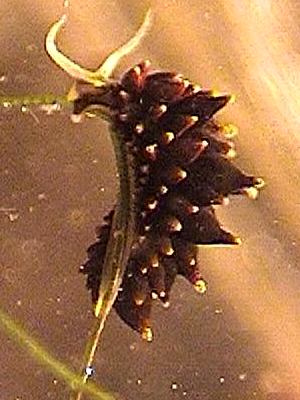
Dear Alexander,
Your animal is a sacoglossan opisthobranch which are herbivorous 'cousins' of the carnivorous nudibranchs. In you photos I can see a hint of filamentous green algae. If that is what your slug is feeding on it is unlikely to be the egg-eating Stiliger bellulus. From you photos it does seem to be a species of Stiliger. I have no published scientific infomation available to me on the Black Sea opisthobranch fauna and I don't know of a species with this colour from the Mediterranean. Hopefully someone more familiar than I am with the sacoglossans of the region will be able to identify your animal. In the mean time it would be interesting to have a little background information on where and when you found it, what it was feeding on, and its length.
Best wishes,
Bill Rudman
